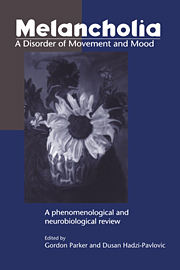Book contents
- Frontmatter
- Contents
- List of contributors
- Acknowledgments
- Introduction
- Part One Classification and Research: Historical and Theoretical Aspects
- Part Two Development and Validation of a Measure of Psychomotor Retardation as a Marker of Melancholia
- 5 Psychomotor Change as a Feature of Depressive Disorders: Historical Overview and Current Assessment Strategies
- 6 Development and Structure of the CORE System
- 7 Reliability of the CORE Measure
- 8 Validity of the CORE: I. A Neuroendocrinological Strategy
- 9 Validity of the CORE: II. Neuropsychological Tests
- 10 Validity of the CORE: III. Outcome and Treatment Prediction
- 11 Phenotypic Expression of Melancholia Contrasted for Those with Bipolar and Unipolar Illness Courses
- 12 Psychotic Depression: Clinical Definition, Status and the Relevance of Psychomotor Disturbance to Its Definition
- 13 A Clinical Algorithm for Defining Melancholia: Comparison with Other Sub-typing Measures
- 14 Rating the CORE: A User's Guide
- Part Three The Neurobiology of Melancholia
- The CORE Measure: Procedural Recommendations and Rating Guidelines
- References
- Author Index
- Subject Index
14 - Rating the CORE: A User's Guide
from Part Two - Development and Validation of a Measure of Psychomotor Retardation as a Marker of Melancholia
Published online by Cambridge University Press: 04 August 2010
- Frontmatter
- Contents
- List of contributors
- Acknowledgments
- Introduction
- Part One Classification and Research: Historical and Theoretical Aspects
- Part Two Development and Validation of a Measure of Psychomotor Retardation as a Marker of Melancholia
- 5 Psychomotor Change as a Feature of Depressive Disorders: Historical Overview and Current Assessment Strategies
- 6 Development and Structure of the CORE System
- 7 Reliability of the CORE Measure
- 8 Validity of the CORE: I. A Neuroendocrinological Strategy
- 9 Validity of the CORE: II. Neuropsychological Tests
- 10 Validity of the CORE: III. Outcome and Treatment Prediction
- 11 Phenotypic Expression of Melancholia Contrasted for Those with Bipolar and Unipolar Illness Courses
- 12 Psychotic Depression: Clinical Definition, Status and the Relevance of Psychomotor Disturbance to Its Definition
- 13 A Clinical Algorithm for Defining Melancholia: Comparison with Other Sub-typing Measures
- 14 Rating the CORE: A User's Guide
- Part Three The Neurobiology of Melancholia
- The CORE Measure: Procedural Recommendations and Rating Guidelines
- References
- Author Index
- Subject Index
Summary
Basic Instructions
This chapter focuses on some of the practicalities of rating individual core items and should be read in conjunction with the measure itself (see Appendix).
Intended Use of the Instrument. The instrument can be used (i) to assist with and enrich the normal clinical interview of depressed patients, and (ii) to sub-type depressed patients into melancholic and non-melancholic groups for clinical or research purposes. As the instrument rates observed behavioural nuances, clinical experience with depressed patients (especially the severely depressed) is required. While training is necessary to ensure accuracy in research studies, these guidelines may assist many to a reasonable standard.
It is important to emphasise that the core system is not a diagnostic measure distinguishing (say) melancholia from dementia. It is a sub-typing system, to be used when a diagnosis of a primary depression has been made and when division into melancholic and non-melancholic type is required, or when a probability estimate of melancholia is sought.
Timing of the Ratings During Clinical Interview. It is recommended that core ratings do not take place in the first 20 minutes of the interview. This time period should enable very anxious subjects to settle and to assist the rater in discriminating between anxiety and agitation. While no formal tests of diurnal effects have been made, all things being equal, morning ratings are likely to be better for capturing psychomotor retardation and agitation, which appear, respectively, to be more severe and frequent early in the day.
- Type
- Chapter
- Information
- Melancholia: A Disorder of Movement and MoodA Phenomenological and Neurobiological Review, pp. 211 - 220Publisher: Cambridge University PressPrint publication year: 1996
- 3
- Cited by

